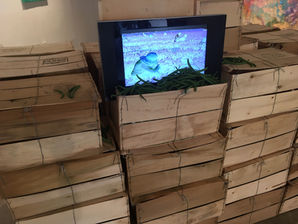Unseen Field Culture: Florida
In Unseen Field Culture, I turn my lens toward the hidden labor and ecological violence embedded in South Florida’s agricultural industry. Created during my time as ProjectArt’s artist-in-residence in Homestead, Florida, this work blends ethnographic fieldwork, video, sculpture, and installation to trace the life of the humble green bean—a ubiquitous but invisible cornerstone of the American food system.
Homestead, once rich cropland, is rapidly suburbanizing, yet vast tracts remain dedicated to intensive monoculture farming. Beneath the surface of neatly packed supermarket produce lies an unseen world of synthetic chemical dependency, systemic labor exploitation, and environmental degradation. I sought to reveal these layered systems, traveling the same backroads as the former school buses that transport migrant workers to harvest fields coated in herbicides, fungicides, pesticides, and chemical fertilizers.
As an artist and a mother committed to living close to the land, I was drawn to the green bean fields by both personal instinct and political urgency. Armed with a field recorder and a camera, I approached harvesting crews—primarily older Haitian immigrants compensated by weight under precarious third-party contracts. My encounter revealed a vanishing tradition of human-centered harvest, pressured by mechanization and threatened by immigration policy. The laborers' rhythmic work, rich with dignity yet marked by vulnerability, formed the core sensory material of the project.
Following the bean’s journey from field to packing house, I documented the industrial choreography: conveyor belts, forklifts, human hands sorting "good" from "waste," with rejected beans cascading into cull trailers like discarded bodies. This project culminated in a multisensory installation at the Museum of Contemporary Art North Miami, featuring gathered field objects, recordings, and obscured video footage to protect the identities of workers.
Context and Meaning:
Unseen Field Culture stands within a lineage of socially engaged art that foregrounds the invisible systems shaping everyday life—from the land art movement’s critiques of extraction, to contemporary discussions of agroecology, race, and labor. The work echoes traditions of both documentary practice and ritual gesture, weaving together documentation, protection, and a call for witness.
It questions who feeds America—and at what cost. It invites viewers to reimagine their relationship with the land, the hands that work it, and the systems that distance them from both.
Every harvest leaves a trace on the body, the soil, the breath.

Unseen Field Culture Installtions in Little Havana and the Museum of Contemporary Art North Miaim in Miami 2018

During my time as an artist-in-residence at the Homestead Branch Library through ProjectArt, I immersed myself in the community where I lived—teaching, listening, and observing the complex interweaving of land, labor, and life. Homestead, Florida, a place where suburban neighborhoods quickly swallow former farmland, still holds vast expanses of cropland between its new developments. Here, monoculture dominates: vast fields dedicated to one or two crops, owned by distant corporations, managed through contracts, and maintained through relentless chemical intervention.
One crop in particular caught my attention: the green bean. South Florida is the largest producer of green beans in the United States, with an estimated 33,000 acres under cultivation. At harvest, former school buses roll off the highways into the backroads, carrying Haitian laborers to the fields. It is a poignant and unsettling sight—beautiful, rhythmic, but burdened with profound questions: Who are these workers? What are they exposed to in these fields soaked with herbicides, pesticides, and fungicides? How are they compensated for their labor, their time, their health?
I began to document what I encountered. With a field recorder and camera, I entered the fields, capturing the percussive sound of beans hitting buckets long before the workers' hands came into view. Welcomed at first by smiles and greetings, I was quickly intercepted by managers who forbade documentation. Still, conversations emerged: the workers were largely Haitian, brought by bus, paid by weight. The field manager lamented the decline of this human labor force, admitting machines could not replicate the precision and tenderness of the human hand. He concluded, ominously, that the real threat was not technological change, but immigration policy—"the only real threat is Trump sending them all back."
Tracing the green bean’s journey beyond the field, I followed them into the pack houses where beans are sorted, boxed, and loaded for national distribution. The choreography of labor continued: hands swiftly picking, machines spinning, forklifts whirring. Behind the spectacle, a darker story played out—tons of culled, rejected beans dumped into waiting trucks, destined for compost or waste.
This project gathers together elements from this ethnographic journey—field recordings, photographs, video installations, and living materials. For my installation at the Museum of Contemporary Art North Miami, I layered these documents with caution: obscuring the faces of workers, acknowledging the precarity and invisibility of those whose hands nourish a nation.
Field Culture Unseen seeks to surface what industrial agriculture demands we overlook—the living ecosystems of labor, land, and toxicity that feed a culture of consumption. It asks what it means to live adjacent to these fields, to witness, to touch, and to reckon with the unseen fields within and beyond ourselves.













